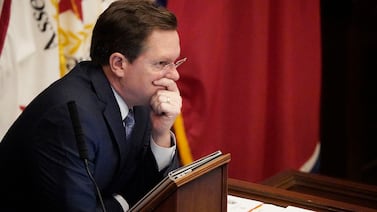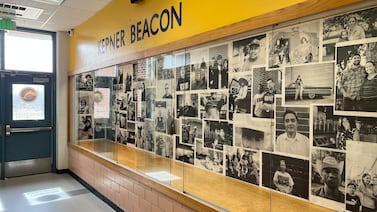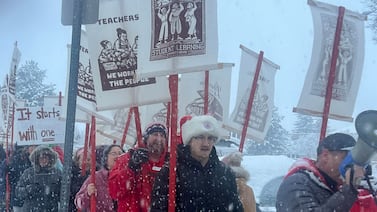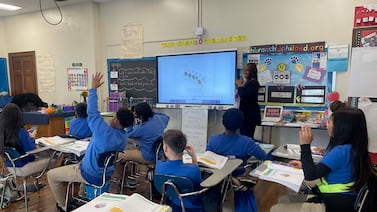Sign up for Chalkbeat Chicago’s free daily newsletter to keep up with the latest news on Chicago Public Schools.
Rachael Mahmood has been on the road for the past year asking educators across Illinois about what belonging means to them and what school districts can do to support educators.
Mahmood, a veteran elementary school teacher at Indian Prairie School District 204, was named Illinois Teacher of the Year in 2024. One of the perks of the title is being able to take a year off to pursue professional development. Mahmood decided to spend the year traveling around the state facilitating conversations about belonging, known as World Cafes, with educators and school communities.
As a student of color growing up in a predominantly white suburb outside of Chicago, Mahmood always felt like an outsider and has been on a search to figure out how to ensure students and educators feel like they belong.
“Right now, a lot of people are talking about how do we attract teachers to the field, how do we attract students to become teachers, and how do we retain teachers,” said Mahmood regarding the idea behind her project. “And so I kind of married that need right now in the community with this idea of belonging.”
Throughout the year, Mahmood organized about 50 meetings across Illinois, which attracted crowds ranging from 30 to 600 people. All told, thousands came to the gatherings, held at schools, colleges, and education conferences. About 2,500 of them took a post-workshop survey, and almost 2,000 of the respondents work in schools. The meetings were open to educators, students, and families. Mahmood traveled all over the state, visiting school communities in rural, suburban, and urban areas.
Mahmood would ask participants to sit in small groups, and she would provide them with discussion topics, such as how they define belonging, what their schools strengths and challenges are when it comes to making people feel like they belong, and what action steps they want to see their school take to increase a sense of belonging. Right after, she would survey the groups.
Mahmood took the data she received from participants and ran it through an artificial intelligence program that helped her understand what participants wanted. She found that many of the teachers’ answers differed based on their racial or ethnic background and their years of service.
In an interview with Chalkbeat Chicago, Mahmood shared her findings and what educators told her about their experiences at these World Cafes.
This story has been lightly edited for length and clarity.
How did educators define belonging in the meetings?
So the first thing I learned about defining belonging is that it’s deeply personal, and it’s different for everybody. School districts need to know how their educators define belonging, how their students define belonging, and how their students’ families define belonging. And the only way to find that out is to ask them, right? Because school districts can be taking many well-intentioned steps towards inclusion, but it’s ultimately our feelings of belonging which show them those steps have actually landed. No matter what demographic you came from, safety and security were a big theme that came out of how we define belonging.
Were there differences between how teachers defined belonging?
Hispanic participants did have a priority on safe and secure environments. They were emphasizing more words that involve psychological safety and being free from judgment. African American participants predominantly defined belonging through school culture and community. They were emphasizing words like “authenticity,” “affirmation,” and “visibility,” and they referred to the school being like a home. White educators tended to mirror the overall trend about safe environments, empathy, and voice. Asian American educators frequently named empathy and team connection — looking at interpersonal relations, like warmth, knowing each other’s name, greeting each other, those types of one-to-one kind of connections.
Our early career educators, those with between one to five years [in the classroom], prioritize safe and secure environments and school culture, but they had a heavy influence on belonging and celebrating diverse cultures. But those who are mid and later career educators had a stronger emphasis on hearing all stakeholders’ voices in the way they define belonging.
What did teachers say when you asked them what their greatest strengths were when it comes to creating a space of belonging at school?
The greatest strength that educators talked about was basically this idea of being empathetic and responsive to each other. They really named their colleagues as their greatest strengths. They said things like “My colleagues are supportive. My colleagues are welcoming. My school is welcoming. My colleagues are kind. We take care of each other.” This idea of trust and teacher care.
What were the barriers to belonging in schools for teachers?
The most frequently expressed barriers, this is ironic, was the way staff engages with each other. Our greatest strength is our colleagues; we have the power to lift each other up and support each other, and that means a lot to us as educators. But at the same time, we have to be careful with each other’s hearts. We have to know each other’s stories.
Black teachers said staff diversity was their dominant concern. They talked about diversity in the sense of themselves being from a diverse background, as well as how we treat students. Hispanic educators focused more on staff engagement, how we talk to each other, how we treat each other. But they talked about how we treat them as Hispanic teachers, and they talked a lot about how we treat and support families. Asian American staff members frequently cited a lack of cultural knowledge about students and families, which is not surprising, because Asia has so many different cultures and languages and traditions and religions. For white staff, their biggest challenge was barriers to feeling included, but they were mostly talking about barriers that their students and families face.
What actions did educators suggest to make teachers, students, and families feel like they belong?
Staff engagement again. A lot of actions around building teacher trust and care. Even some actions around how do we empower students, and how do we increase communication? Those were kind of the four themes.
What were some takeaways you had from the conversations that you hosted so far?
What’s most important is if we want people to feel a sense of belonging, we gotta ask them what belonging means to them. We have to honor what it means to them, and we have to strive and align our actions towards those outcomes. Otherwise, we may be doing many things to help people feel [a sense of] belonging, but they may not be feeling it because that’s not the way they define it, or it may not be landing in the ways we’re hoping that it would land.
How did educators feel about the meetings?
Once I started sharing my story, the vulnerability in the way that I share my story, it primed the conversation in a way that everyone was an engaged participant. They left affirmed in the whole experience. People were coming up afterwards and saying, ‘This was the most amazing professional development we’ve done all year. This was the best institute day we had all year. We should start every year with an activity like this.’ People felt heard.
With all the information that you gathered through these conversations, what do you plan to do now?
I’m working on writing a book right now. Well, I don’t know if it’s gonna be a book, but, like, a manual/light reading book that talks about what I learned from this experience. I’m going to talk about the need to center educator voices in spaces where educators are impacted. The need to center the voices of our community, having more community-driven definitions, and community-driven actions.
Correction: June 20, 2025: A previous version of this reported that about 2,500 attended Mahmood’s World Cafes. This story has been updated to reflect that about 2,500 participants took a post-workshop survey.
Samantha Smylie is the state education reporter for Chalkbeat Chicago, covering school districts across the state, legislation, special education, and the state board of education. Contact Samantha at ssmylie@chalkbeat.org.








